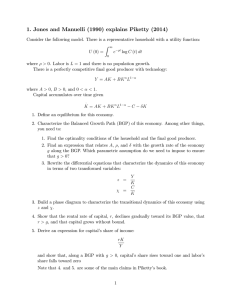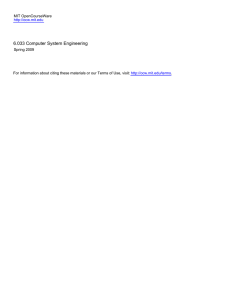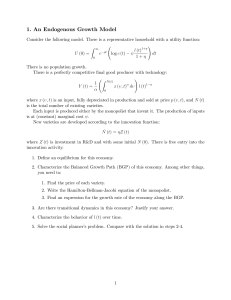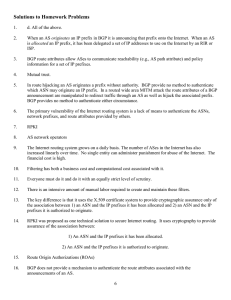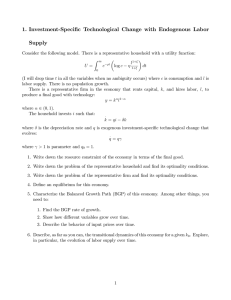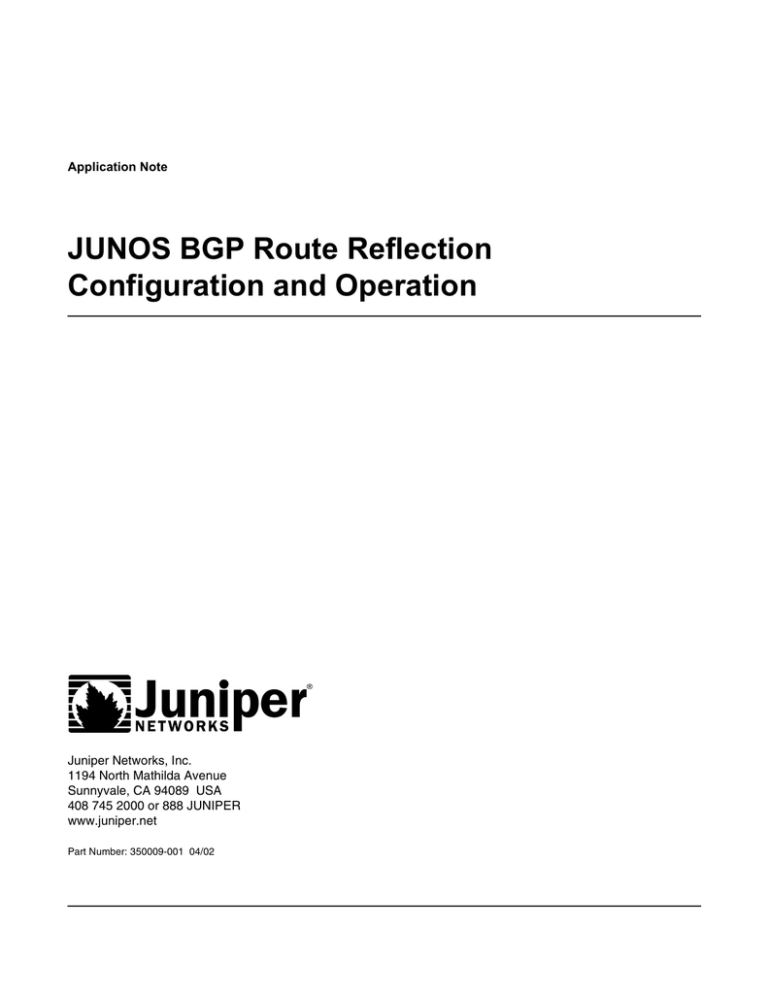
Application Note
JUNOS BGP Route Reflection
Configuration and Operation
Juniper Networks, Inc.
1194 North Mathilda Avenue
Sunnyvale, CA 94089 USA
408 745 2000 or 888 JUNIPER
www.juniper.net
Part Number: 350009-001 04/02
Contents
Purpose . . . . . . . . . . . . . . . . . . . . . . . . . . . . . . . . . . . . . . . . . . . . . . . . . . . . . . . . . . . . . . . . . . . . . . . 3
Requirements . . . . . . . . . . . . . . . . . . . . . . . . . . . . . . . . . . . . . . . . . . . . . . . . . . . . . . . . . . . . . . . . . . 3
Terms . . . . . . . . . . . . . . . . . . . . . . . . . . . . . . . . . . . . . . . . . . . . . . . . . . . . . . . . . . . . . . . . . . . . 3
Setup . . . . . . . . . . . . . . . . . . . . . . . . . . . . . . . . . . . . . . . . . . . . . . . . . . . . . . . . . . . . . . . . . . . . . . . . . 3
Operation . . . . . . . . . . . . . . . . . . . . . . . . . . . . . . . . . . . . . . . . . . . . . . . . . . . . . . . . . . . . . . . . . . . . . 5
Analysis . . . . . . . . . . . . . . . . . . . . . . . . . . . . . . . . . . . . . . . . . . . . . . . . . . . . . . . . . . . . . . . . . . . . . . 6
Additional Notes . . . . . . . . . . . . . . . . . . . . . . . . . . . . . . . . . . . . . . . . . . . . . . . . . . . . . . . . . . . . . 12
References . . . . . . . . . . . . . . . . . . . . . . . . . . . . . . . . . . . . . . . . . . . . . . . . . . . . . . . . . . . . . . . . . . . 12
List of Figures
Figure 1: BGP Route Reflection Advertisement within an IBGP Configuration . . . . . . . . . 4
Figure 2: BGP Route Reflection Advertisement within an EBGP Configuration . . . . . . . . 11
Copyright © 2002, Juniper Networks, Inc.
Purpose
This technical note describes the configuration and operation of BGP route reflection in the
JUNOS Internet software.
Requirements
One method to work around the need to have a full-mesh Internal BGP (IBGP) network is to
use BGP route reflection. Before we discuss the route reflection configuration and operation in
the JUNOS, it is important to understand the meaning of common terms used in this type of
network design.
Terms
Cluster ID – The cluster ID is a configured four-octet value that identifies a route reflector and
its clients.
Nonclient peer – Nonclient peers are routers that have a BGP session with the RR, but are not
considered clients. Unlike RR clients, nonclient peers in the same autonomous system (AS) as
the RR must be fully meshed.
Route reflector (RR) – The RR is the router responsible for the re-advertisement or the
reflection of routes.
Router reflector client (RR client) – The RR client is the router that relies on the RR to
advertise and to learn routes to and from the rest of the network. RR clients of the same RR
might or might not be fully meshed.
Setup
In Figure 1, routers Iggy, Scorch and Roam are all in cluster 2.2.2.2. Iggy is the RR and Scorch
and Roam are its RR clients. Router Congo3, a nonclient peer, has an IBGP session with Iggy.
In addition to Scorch being an RR client of Iggy, it is also serving as the RR in cluster 3.3.3.3
with Paul as its RR client.
Copyright © 2002, Juniper Networks, Inc.
3
BGP Route Reflection Configuration and Operation
Figure 1: BGP Route Reflection Advertisement within an IBGP Configuration
AS 100
cluster
3.3.3.3
202.1.1/24
scorch
Router ID: 3.3.3.3
201.1.1/24
••••••••••••••
M40e
paul
Router ID: 4.4.4.4
M40e
200.1.1/24
M40e
M40e
iggy
Router ID: 2.2.2.2
M40e
congo3
Router ID: 5.5.5.5
roam
Router ID: 1.1.1.1
Cluster
2.2.2.2
The following is the BGP configuration on Iggy.
protocols {
bgp {
export static-to-bgp;
group ibgp {
type internal;
local-address 2.2.2.2;
peer-as 100;
neighbor 5.5.5.5;
}
group rrcluster {
type internal;
local-address 2.2.2.2;
cluster 2.2.2.2;
peer-as 100;
neighbor 1.1.1.1;
neighbor 3.3.3.3;
}
}
The cluster statement indicates that Iggy is a route reflector for this BGP group, and the neighbor
statements define the two RR clients, which are neighbors 1.1.1.1 and neighbor 3.3.3.3.
Copyright © 2002, Juniper Networks, Inc.
4
BGP Route Reflection Configuration and Operation
The following is the BGP configuration on Scorch.
protocols {
bgp {
group ibgp {
type internal;
local-address 3.3.3.3;
peer-as 100;
neighbor 2.2.2.2;
}
group rrclient {
type internal;
local-address 3.3.3.3;
cluster 3.3.3.3;
peer-as 100;
neighbor 4.4.4.4;
}
}
If you look at the group ibgp portion of Scorch’s configuration, you will notice that it doesn’t
even know that it is a client of Iggy. That is, RR client configuration is the same as a normal
IBGP configuration.
The group rrclient statement configures Scorch as a RR of cluster 3.3.3.3 with router Paul
(neighbor 4.4.4.4) as its client.
Operation
When a RR receives a route, it re-advertises the route using the following rules:
■
If the RR receives a route from a nonclient peer, it reflects the route to all clients.
■
If the RR receives a route from a client peer, it reflects the route to all nonclients and all
client peers except the client who originated the route. (Note: If you configure the
parameter no-client-reflect, the RR does not reflect routes to other clients. Include
this statement only when all the clients are fully meshed.)
If the RR receives a route from an EBGP peer, it reflects the route to all client and nonclient
peers.
In addition to these re-advertisement rules, the RR sets two BGP attributes.
1. Originator ID indicates the router ID of the router that originated the route into BGP.
2. Cluster list records the sequence of clusters that the route has traversed.
The RR uses the following rules when setting these attributes:
■
A RR never adds the cluster ID, cluster list, and originator ID to a route that it received
from an EBGP peer or to a route learned from another protocol other than IBGP (such as
static route) while reflecting.
■
If the reflection is client to client or client to nonclient, the cluster ID, cluster list, and
originator ID are added to the route. An originator ID is created only if one is not set.
The current cluster ID is added to the existing cluster list or a new cluster list is created
if one is not present.
Copyright © 2002, Juniper Networks, Inc.
5
BGP Route Reflection Configuration and Operation
Once set, the originator ID and cluster list attributes are checked to prevent routing loops. The
following routing loop checks are implemented in the JUNOS Internet software.
■
■
■
■
■
If a route is received from a client in a cluster that has our own cluster ID (for the same
cluster), the route is discarded and not installed in the routing table.
If a route is received from a nonclient that has our own cluster ID, the route is accepted
because it might have to be reflected to another cluster if the router is supporting
multiple clusters.
Do not reflect a path back to the originator of the route.
Do not reflect a path to a client if the cluster ID of the cluster to which the client belongs
is included in the cluster list.
Discard any route received if the originator ID is the same as our router ID.
Analysis
Looking again at Figure 1. Look at three routes on the different routers.
1. Route 200.1.1/24
(a) Congo3 advertises the route to Iggy using IBGP.
On Iggy:
200.1.1.0/24 (1 entry, 1 announced)
*BGP
Preference: 170/-101
Source: 5.5.5.5
Nexthop: 104.1.1.1 via at-0/0/0.0, selected
State: <Active Int Ext>
Local AS:
100 Peer AS:
100
Age: 7:03
Metric2: 1
Task: BGP_100.5.5.5.5+179
Announcement bits (3): 0-KRT 4-BGP.0.0.0.0+179
5-BGP_Sync_Any
AS path: I
BGP next hop: 5.5.5.5
Localpref: 100
Router ID: 5.5.5.5
(b) Iggy adds the cluster ID 2.2.2.2 to the cluster list, sets the originator ID to 5.5.5.5, and then
reflects it to Scorch and Roam.
On Scorch:
200.1.1.0/24 (1 entry, 1 announced)
*BGP
Preference: 170/-101
Source: 2.2.2.2
Nexthop: 101.1.1.1 via at-5/2/1.0, selected
State: <Active Int Ext>
Local AS:
100 Peer AS:
100
Age: 4:56
Metric2: 2
Task: BGP_100.2.2.2.2+179
Announcement bits (3): 0-KRT 4-BGP.0.0.0.0+179
5-BGP_Sync_Any
AS path: I <Originator>
Cluster list: 2.2.2.2
Originator ID: 5.5.5.5
BGP next hop: 5.5.5.5
Localpref: 100
Router ID: 2.2.2.2
Copyright © 2002, Juniper Networks, Inc.
6
BGP Route Reflection Configuration and Operation
On Roam:
200.1.1.0/24 (1 entry, 1 announced)
*BGP
Preference: 170/-101
Source: 2.2.2.2
Nexthop: 100.1.1.2 via at-1/3/0.0, selected
State: <Active Int Ext>
Local AS:
100 Peer AS:
100
Age: 14 Metric2: 2
Task: BGP_100.2.2.2.2+179
Announcement bits (2): 0-KRT 5-BGP_Sync_Any
AS path: I <Originator>
Cluster list: 2.2.2.2
Originator ID: 5.5.5.5
BGP next hop: 5.5.5.5
Localpref: 100
Router ID: 2.2.2.2
(c) Scorch adds the cluster ID 3.3.3.3 to the cluster list and reflects the route to Paul.
On Paul:
200.1.1.0/24 (1 entry, 1 announced)
*BGP
Preference: 170/-101
Source: 3.3.3.3
Nexthop: 102.1.1.1 via at-2/2/0.0, selected
State: <Active Int Ext>
Local AS:
100 Peer AS:
100
Age: 5:59
Metric2: 4
Task: BGP_100.3.3.3.3+1487
Announcement bits (2): 2-KRT 5-BGP_Sync_Any
AS path: I <Originator>
Cluster list: 3.3.3.3 2.2.2.2
Originator ID: 5.5.5.5
BGP next hop: 5.5.5.5
Localpref: 100
Router ID: 3.3.3.3
2. Route 201.1.1/24
(a) Iggy injects the static route into BGP.
On Iggy:
protocols {
bgp {
export static-to-bgp;
…
}
policy-options {
policy-statement static-to-bgp {
from {
protocol static;
route-filter 201.1.1.0/24 exact;
}
then accept;
}
}
Copyright © 2002, Juniper Networks, Inc.
7
BGP Route Reflection Configuration and Operation
(b) Iggy advertises the route to Congo3, Scorch and Roam. It does not add an originator ID
and cluster information because this information is learned from the protocol static
statement in the static-to-bgp policy.
On Congo3:
201.1.1.0/24 (1 entry, 1 announced)
*BGP
Preference: 170/-101
Source: 2.2.2.2
Nexthop: 104.1.1.2 via en0.0, selected
State: <Active Int Ext>
Local AS:
100 Peer AS:
100
Age: 3:02
Metric2: 2
Task: BGP_100.2.2.2.2+1038
Announcement bits (2): 0-KRT 5-BGP_Sync_Any
AS path: I
BGP next hop: 2.2.2.2
Localpref: 100
Router ID: 2.2.2.2
On Scorch:
201.1.1.0/24 (1 entry, 1 announced)
*BGP
Preference: 170/-101
Source: 2.2.2.2
Nexthop: 101.1.1.1 via at-5/2/1.0, selected
State: <Active Int Ext>
Local AS:
100 Peer AS:
100
Age: 4:56
Metric2: 2
Task: BGP_100.2.2.2.2+179
Announcement bits (3): 0-KRT 4-BGP.0.0.0.0+179
5-BGP_Sync_Any
AS path: I
BGP next hop: 2.2.2.2
Localpref: 100
Router ID: 2.2.2.2
On Roam:
201.1.1.0/24 (1 entry, 1 announced)
*BGP
Preference: 170/-101
Source: 2.2.2.2
Nexthop: 100.1.1.2 via at-1/3/0.0, selected
State: <Active Int Ext>
Local AS:
100 Peer AS:
100
Age: 14 Metric2: 2
Task: BGP_100.2.2.2.2+179
Announcement bits (2): 0-KRT 5-BGP_Sync_Any
AS path: I
BGP next hop: 2.2.2.2
Localpref: 100
Router ID: 2.2.2.2
Copyright © 2002, Juniper Networks, Inc.
8
BGP Route Reflection Configuration and Operation
(c) Scorch adds cluster ID 3.3.3.3 to the cluster list, sets originator ID to 2.2.2.2, and then
reflects the route to Paul.
On Paul:
201.1.1.0/24 (1 entry, 1 announced)
*BGP
Preference: 170/-101
Source: 3.3.3.3
Nexthop: 102.1.1.1 via at-2/2/0.0, selected
State: <Active Int Ext>
Local AS:
100 Peer AS:
100
Age: 5:59
Metric2: 4
Task: BGP_100.3.3.3.3+1487
Announcement bits (2): 2-KRT 5-BGP_Sync_Any
AS path: I <Originator>
Cluster list: 3.3.3.3
Originator ID: 2.2.2.2
BGP next hop: 2.2.2.2
Localpref: 100
Router ID: 3.3.3.3
3. Route 202.1.1/24
(a) Paul advertises the route to Scorch.
On Scorch:
202.1.1.0/24 (1 entry, 1 announced)
*BGP
Preference: 170/-101
Source: 4.4.4.4
Nexthop: 102.1.1.2 via at-5/2/0.0, selected
State: <Active Int Ext>
Local AS:
100 Peer AS:
100
Age: 3:10
Metric2: 2
Task: BGP_100.4.4.4.4+179
Announcement bits (3): 0-KRT 4-BGP.0.0.0.0+179
5-BGP_Sync_Any
AS path: I
BGP next hop: 4.4.4.4
Localpref: 100
Router ID: 4.4.4.4
(b) Scorch adds the cluster ID 3.3.3.3 to the cluster list, sets the originator ID to 4.4.4.4 and
reflects the route to Iggy.
On Iggy:
202.1.1.0/24 (1 entry, 1 announced)
*BGP
Preference: 170/-101
Source: 3.3.3.3
Nexthop: 101.1.1.2 via at-6/1/1.0, selected
State: <Active Int Ext>
Local AS:
100 Peer AS:
100
Age: 2:25
Metric2: 3
Copyright © 2002, Juniper Networks, Inc.
9
BGP Route Reflection Configuration and Operation
Task: BGP_100.3.3.3.3+1488
Announcement bits (3): 0-KRT 4-BGP.0.0.0.0+179
5-BGP_Sync_Any
AS path: I <Originator>
Cluster list: 3.3.3.3
Originator ID: 4.4.4.4
BGP next hop: 4.4.4.4
Localpref: 100
Router ID: 3.3.3.3
(c) Iggy adds the cluster ID 2.2.2.2 to the cluster list and reflects the route to Congo3 and Roam.
On Congo3:
202.1.1.0/24 (1 entry, 1 announced)
*BGP
Preference: 170/-101
Source: 2.2.2.2
Nexthop: 104.1.1.2 via en0.0, selected
State: <Active Int Ext>
Local AS:
100 Peer AS:
100
Age: 1:15
Metric2: 4
Task: BGP_100.2.2.2.2+1038
Announcement bits (2): 0-KRT 5-BGP_Sync_Any
AS path: I <Originator>
Cluster list: 2.2.2.2 3.3.3.3
Originator ID: 4.4.4.4
BGP next hop: 4.4.4.4
Localpref: 100
Router ID: 2.2.2.2
On Roam:
202.1.1.0/24 (1 entry, 1 announced)
*BGP
Preference: 170/-101
Source: 2.2.2.2
Nexthop: 100.1.1.2 via at-1/3/0.0, selected
State: <Active Int Ext>
Local AS:
100 Peer AS:
100
Age: 14 Metric2: 4
Task: BGP_100.2.2.2.2+179
Announcement bits (2): 0-KRT 5-BGP_Sync_Any
AS path: I <Originator>
Cluster list: 2.2.2.2 3.3.3.3
Originator ID: 4.4.4.4
BGP next hop: 4.4.4.4
Localpref: 100
Router ID: 2.2.2.2
Copyright © 2002, Juniper Networks, Inc.
10
BGP Route Reflection Configuration and Operation
In Figure 2, router Congo3 now belongs to a different AS (AS 200).
Figure 2: BGP Route Reflection Advertisement within an EBGP Configuration
AS 100
cluster
3.3.3.3
202.1.1/24
scorch
Router ID: 3.3.3.3
AS 200
201.1.1/24
••••••••••••••
M40e
paul
Router ID: 4.4.4.4
M40e
200.1.1/24
M40e
iggy
Router ID: 2.2.2.2
M40e
M40e
congo3
Router ID: 5.5.5.5
Cluster
2.2.2.2
roam
Router ID: 1.1.1.1
The route advertisements are the same as the example above in Figure 1, except that now Iggy
does not set the originator ID and the cluster list attributes when it reflects the route to Scorch
and Roam because the route is now received from EBGP.
On Scorch:
200.1.1.0/24 (1 entry, 1 announced)
*BGP
Preference: 170/-101
Source: 2.2.2.2
Nexthop: 101.1.1.1 via at-5/2/1.0, selected
State: <Active Int Ext>
Local AS:
100 Peer AS:
100
Age: 2:17
Metric2: 2
Task: BGP_100.2.2.2.2+179
Announcement bits (3): 0-KRT 4-BGP.0.0.0.0+179
5-BGP_Sync_Any
AS path: 200 I
BGP next hop: 104.1.1.1
Localpref: 100
Router ID: 2.2.2.2
On Roam:
200.1.1.0/24 (1 entry, 1 announced)
*BGP
Preference: 170/-101
Source: 2.2.2.2
Nexthop: 100.1.1.2 via at-1/3/0.0, selected
State: <Active Int Ext>
Copyright © 2002, Juniper Networks, Inc.
11
BGP Route Reflection Configuration and Operation
Local AS:
100 Peer AS:
100
Age: 3:16
Metric2: 2
Task: BGP_100.2.2.2.2+179
Announcement bits (2): 0-KRT 5-BGP_Sync_Any
AS path: 200 I
BGP next hop: 104.1.1.1
Localpref: 100
Router ID: 2.2.2.2
Additional Notes
When you are trying to debug BGP problems, it is helpful to enable BGP tracing operations to
log important messages into a file. To do this, include the traceoptions statement under
BGP. You can configure different traceoptions flags to filter the information that is logged.
In this example, the user configures BGP traceoptions to log BGP keepalive messages.
protocols {
bgp {
traceoptions {
file bgp.log replace size 1m files 2;
flag keepalive;
}
For a list of the different traceoptions flags, refer to the JUNOS Internet Software
Configuration Guide.
References
Configure Route Reflection in the BGP Configuration Guidelines of the JUNOS Internet
Software Configuration Guide.
RFC 1966 (BGP Route Reflection: An alternative to full mesh IBGP)
Copyright © 2002, Juniper Networks, Inc. All rights reserved. Juniper Networks is registered in the U.S. Patent and Trademark Office and in other countries
as a trademark of Juniper Networks, Inc. Broadband Cable Processor, G10, Internet Processor, JUNOS, JUNOScript, M5, M10, M20, M40, M40e, M160,
M-series, T640, and T-series, are trademarks of Juniper Networks, Inc. All other trademarks, service marks, registered trademarks, or registered service marks
are the property of their respective owners. All specifications are subject to change without notice.
Juniper Networks assumes no responsibility for any inaccuracies in this document. Juniper Networks reserves the right to change, modify, transfer, or otherwise
revise this publication without notice.
Copyright © 2002, Juniper Networks, Inc.
12

